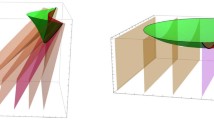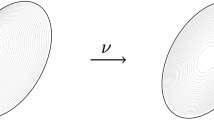Abstract
Two initial-value problems are considered involving a parameter \(\alpha \), the corresponding steady states have a critical value at \(\alpha =\alpha _c<0\) with steady state solutions possible only if \(\alpha \ge \alpha _c\). The aim is to compare how the solution to these two problems evolves in time. For the first problem we find that a solution exists for all time with a two-region structure having a self-similar relatively thin front region moving away from the wall and an inner inviscid region, increasing exponentially in thickness at a rate proportional to \(\hbox {e}^{|\alpha |\,t}\). A finite-time singularity develops in the second problem, the nature of this singularity being derived in terms of the time difference \(\tau =t_s-t\), where the singularity occurs at time \(t_s\), showing that the velocity becomes singular at a rate proportional to \(\tau ^{-1}\) and the thickness of the boundary-layer increasing at a rate proportional to \(\tau ^{-1/2}\).










Similar content being viewed by others
References
Wilks G, Bramley JS (1981) Dual solutions in mixed convection. Proc R Soc Edinb 87A:349–358
Mahmood T, Merkin JH (1988) Similarity solutions in axisymmetric mixed convection boundary-layer flow. J Eng Math 22:73–92
Merkin JH, Mahmood T (1989) Mixed convection boundary layer similarity solutions: prescribed wall heat flux. J Appl Math Phys (ZAMP) 40:51–68
Merkin JH, Pop I (2002) Mixed convection on a vertical surface: similarity solutions for uniform flow. Fluid Dyn Res 30:233–250
Revnic C, Grosan T, Merkin JH, Pop I (2009) Mixed convection flow near an axisymmetric stagnation point on a vertical cylinder. J Eng Math 64:1–13
Isak A, Merkin JH, Nazar R, Pop I (2008) Mixed convection boundary layer flow over a permeable vertical surface with prescribed wall heat flux. Z Angew Math Phys (ZAMP) 59:100–123
Nazar R, Amin N, Pop I (2004) Unsteady mixed convection boundary layer flow near the stagnation point on a vertical surface in a porous medium. Int J Heat Mass Transf 47:2681–2688
Ling SC, Nazar R, Pop I, Merkin JH (2009) Mixed convection boundary-layer flow in a porous medium filled with water close to its maximum density. Transp Porous Media 76:139–151
Riley N, Weidman PD (1989) Multiple solutions for the Falkner–Skan equation for flow past a stretching boundary. SIAM J Appl Math 49:1350–1358
Weidman PD, Turner MR (2017) Stagnation-point flows with stretching surfaces: a unified formulation and new results. Eur J Mech B Fluids 61:144–153
Fang T, Lee CF, Zhang J (2011) The boundary layers of an unsteady incompressible stagnation-point flow with mass transfer. Int J Nonlinear Mech 46:942–948
Bachok N, Jaradat MA, Pop I (2011) A similarity solution for the flow and heat transfer over a moving permeable flat plate in a parallel free stream. Heat Mass Transf 47:1643–1649
Chaudhary MA, Merkin JH (1994) Free convection stagnation point boundary layers driven by catalytic surface reactions: I. The steady states. J Eng Math 28:145–171
Merkin JH, Chaudhary MA (1994) Free convection boundary layers on vertical surfaces driven by an exothermic reaction. Q J Mech Appl Math 47:405–428
Chaudhary MA, Merkin JH (1995) A simple isothermal model for homogeneous-heterogeneous reactions in boundary-layer flow: I. Equal diffusivities. Fluid Dyn Res 16:311–333
Chaudhary MA, Merkin JH (1995) A simple isothermal model for homogeneous-heterogeneous reactions in boundary-layer flow: II. Different diffusivities for reactant and autocatalyst. Fluid Dyn Res 16:335–359
Klemp JB, Acrivos A (1976) A moving-wall boundary layer with reversed flow. J Fluid Mech 76:363–381
Merkin JH (1985) On dual solutions occurring in mixed convection in a porous medium. J Eng Math 20:171–179
Merrill K, Beauchesne M, Previte J, Paullet J, Weidman P (2006) Final steady flow near a stagnation point on a vertical surface in a porous medium. Int J Heat Mass Transf 49:4681–4686
Merkin JH (1980) Mixed convection boundary-layer flow on a vertical surface in a saturated porous medium. J Eng Math 14:301–313
Mahmood T, Merkin JH (1998) The convective boundary-layer flow on a reacting surface in a porous medium. Transp Porous Media 32:285–298
Merkin JH, Pop I (2000) Free convection near a stagnation point in a porous medium resulting from an oscillatory wall temperature. Int J Heat Mass Transf 43:611–621
Chaudhary MA, Merkin JH (1996) Free convection stagnation point boundary layers driven by catalytic surface reactions: II. Times to ignition. J Eng Math 30:403–415
Merkin JH, Kumaran V (2010) The unsteady MHD boundary-layer flow on a shrinking sheet. Eur J Mech B Fluids 29:357–363
Chapman DR (1950) Laminar mixing of a compressible fluid. NACA Report 958
Stewartson K (1955) On asymptotic expansions in the theory of boundary layers. J. Math. Phys. 13:113–122
Rohni AM, Ahmad S, Pop I, Merkin JH (2012) Unsteady mixed convection boundary layer flow with suction and temperature slip effects near the stagnation-point on a vertical permeable surface embedded in a porous medium. Transport in Porous Media 92:1–14
Author information
Authors and Affiliations
Corresponding author
Appendix
Appendix
A very much simplified and dimensionless version derivation of Eq. (1).
In a porous medium with the flow given by Darcy’s law the flow near a forward stagnation point with an outer flow is given by (in the usual notation)
where \(\beta \) is a parameter measuring convective to outer flow effects. Define a stream function \(\psi \) by \(\psi =x\,f(y,t)\) and taking \(\theta =\theta (y,t)\), as is standard for a stagnation point, the heat transfer (energy) equation gives
with, from (42),
Equation (43) then gives Eq. (1) on putting \(\alpha =1+\beta \).
The solution develops initially in terms of the independent variable \(\eta =y/t^{1/2}\), as is the case in many other problems of this type. This form can be seen, for example, in the small time behaviour for \(\alpha =0.5\) in Fig. 3. The numerical integrations used the variable y to reflect the behaviour at larger times, though this did require a small time step at the start of the numerical solution.
Rights and permissions
About this article
Cite this article
Merkin, J.H. Boundary-layer development beyond a critical value. Meccanica 54, 85–100 (2019). https://doi.org/10.1007/s11012-018-00926-9
Received:
Accepted:
Published:
Issue Date:
DOI: https://doi.org/10.1007/s11012-018-00926-9




